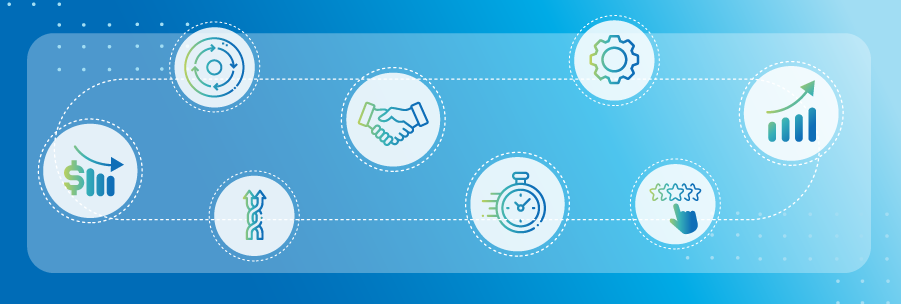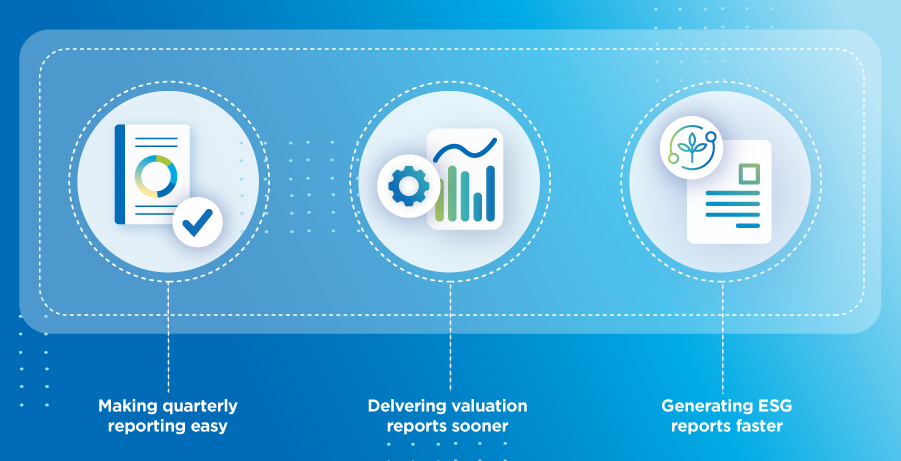Report Automation – Better Reporting for Better Business Practices

Reports are the bread and butter of most organizations. And in this day and age, manual reporting just isn’t going to cut it. You need digitized, reliable data analysis for informed decision-making. And it’s not just business reports anymore. Tons of countries are introducing more environmental, social and governance (ESG) reporting requirements.
So, whether you’re new to the world of intelligent automation (IA), or you already automate some front and back-office tasks but are looking for more opportunities to garner efficiency for your business … Well, you’ve come to the right place. Reports are boring (and tedious) to make, update and share. That makes them perfect IA candidates.
Let’s talk about report automation:
- The software and tools you can use
- The benefits and challenges you might face
- And what to consider when deploying IA in your business
To report, or not to report? That is not the question. The question is, how can you do reporting better? And free your people from monotonous data entry and poorly integrated systems?
What Is Report Automation?
Simply stated, report automation is the process of generating reports automatically. These reports can then be delivered via an automatic email dispatch system.
Hop into the classroom for a moment. IA uses robotic process automation (RPA), artificial intelligence (AI) and business process management (BPM) to automate and streamline workflows. It’s designed to scale across end-to-end business processes to make work better for your people. Plus, it saves time and money for your organization.
Report automation software fetches data from various platforms and areas of the business and brings them into one centralized system. This gives your teams access to real-time reports, which can then be automatically sent to whichever department or person needs them.
IA is the technology, but report automation is the tool you’ll use to extract and update your data, visualize it, generate a report and send the report on a pre-defined schedule. Did we mention it’s 100% accurate and free of human error? And you can view your reports online at any time.
Your automated reports can include key performance indicators (KPIs), financials, digital marketing performances, etc. Automated reporting is essential for businesses inundated with periodic reporting requirements. Without this reporting, your stakeholders and C-suite executives can’t assess your organization’s performance and predict future trends.
What are the challenges with reporting automation?
Some potential challenges to look out for with introducing reporting automation software are:
- Infrastructure and system requirements
- People training
- Budget, resource and time constraints
- Customizability/reporting nuances
- Accessibility and data security
Make sure you know what challenges your business might face as you search for a platform that works for you.
What are the benefits of reporting automation?

If your people are manually gathering data and creating a report – let’s say every month – then sending it on to the relevant stakeholders, we can expect at least the occasional mistake or missed deadline. That work is time-consuming and can be dull. And with an employee building the report, they’re missing the opportunity to work on higher-value, strategic initiatives. They could be analyzing the report and developing predictions instead of copying and pasting data repeatedly.
Or, perhaps you hire an external agency to create these reports. What does that cost you? By automating your reporting, you can realize significant cost savings and allocate resources more effectively.
The benefits of automating reports include:
- Real-time reporting insights and analytics
- Easier accessibility
- Better cross-system integration
- Faster data extraction, collection and report generation
- Reduced employee workload and stress
- Cost and resource savings
- More efficient reporting processes
- Increased consistency and reporting accuracy
What to Consider When Deploying Report Automation
The key is to find an automation tool that aligns with your business goals, resources and infrastructure. Here’s a checklist of questions you should ask when looking for report automation software:
- How often do we need to compile and send reports (e.g., daily, weekly, monthly)?
- How many reports do we need within each cycle?
- What KPIs or data does my business need to measure?
- What formats does my business data come from (e.g., Excel sheets, JPEGs, etc.)?
- How customizable do our reports need to be?
- What system integrations do we need (e.g., Google Analytics, social platforms, etc.)?
- How many system integrations will each report have?
- What is our budget and timescale for setting up this automation tool?
- What training will our people require?
- How many employees will have access to this tool?
- How much support do we need from our automation vendor?
- How will we share our reports (via a website, PDF, automated email, etc.)?
What Tools Can Be Used for Report Automation?

Let’s look at the types of reporting automated tools you might use in your organization:
Low-code or no-code tools
These automation development tools use drag-and-drop elements so your non-tech business users can easily and quickly develop stellar automations. They don’t have to be software developers to use these tools.
Make it simple for your people to automate processes such as:
- Extracting information from various data sources
- Creating and updating data
- Generating reports
- Sending reports
For an intuitive no-code development software platform with user-friendly dashboard tools for building enterprise web applications, we’ve got SS&C | Blue Prism® UX Builder. UX Builder comes pre-integrated with our IA platform and SS&C | Blue Prism® Chorus BPM. Chorus gives you access to a wealth of data-driven insights and services right out of the box, including automation, rules logic and integrations.
Coding tools
Code-based reporting tools will require a specialized tech team to develop your reporting system. A code-based tool has higher starting costs, but you’ll get more customizability into how your reports look and your software functions. These tools will require extra time and costs to script and debug. They may also be more complex. However, if you have a coding team available and have complex reporting requirements, this may be your best option – especially if you’re looking for greater control over the entire reporting system.
KPI dashboards
KPI dashboard tools will track business metrics across different departments and provide real-time visualizations of business performance. They can track metrics across projects, sales, team performances, budgets, etc.
There are three different types of KPI reporting dashboards:
- Analytic: These dashboards show historical data on your organization’s performance and how it changes over time. They tend to provide detailed views of the organization’s financial status and market performance, which can help predict future market trends.
- Strategic: These dashboards focus on process and financial-based KPIs, highlighting bottlenecks and budgeting and investment opportunities.
- Operational: These dashboards are for sales, marketing and customer service. They gather insights on company performance and market trends.
While KPI tools can be useful, they’re less customizable than business intelligence or coding tools and still require some user training.
Business intelligence tools
Business intelligence tools make business data easier to access. They extract insights and predictions about business performance. Within report automation, these tools can help you collate, analyze and visualize your business data in reports or interactive dashboards. These tools usually allow some data analysis customizability across multiple platforms, but they also require training and experience from the business user interpreting the reports.
Reporting automation tools will greatly vary depending on the vendor and your checklist of requirements. It’s best to set your goals and budget first before shopping around.
Proven Reporting Automation Case Studies

It can be challenging to identify what reporting automation software is right for your business. With that, we’d like to share a few reporting success stories from SS&C Blue Prism customers.
Making quarterly reporting easy
A ministry of transport wanted to speed up its process of generating and provisioning ERP evaluations as part of its business-critical quarterly reports. To generate a report, employees had to log into the ERP system, open several screens, enter reporting parameters, and generate and save a PDF file. Long processing lead times and delays in the IT system often left employees sitting unproductively, waiting to move to the next step in the process. The organization deployed SS&C Blue Prism intelligent automation to reduce the time-consuming manual tasks for their people. They implemented digital workers in only ten days. Now, the digital workers log into the ERP system and complete the reporting process from end to end. They generate the reports in record time: fifteen times faster than before.
The results:
- Digital workers reduced 93% of processing time
- Gave 120 hours back to the business each year
- Reports generated 15x faster than before
Delivering valuation reports sooner
A building society introduced an SS&C Blue Prism digital worker to offload valuation reporting tasks from employees to reduce their substantial workload. This organization determines the value of a home – a critical function in the mortgage lending process. Once a property was assessed, an employee had to generate a valuation report. This report was manually downloaded, and the data was inputted into their secure internal system. Due to the high volume of reports and the laborious nature of the task, key information could sometimes be missed or left incomplete. This required further manual detective work and delayed the mortgage process. However, now that the building society has introduced a digital worker, it automatically checks third-party portals for new valuation reports and downloads them to the organization’s back-office system. It then checks each report for missing information and adds the necessary data to the form. Finally, the digital worker sends the completed report to their human colleagues.
The results:
- Increased compliance with government regulations
- 4.5 working days returned to lending operations staff in just one month
- Error-free and timely reports
Generating ESG reports 75% faster
A financial services provider implemented automatic report generation to improve the accuracy and speed of their ESG reporting. The organization had to take critical data from extremely data-heavy, excel-based reports, making their daily downloads and file creation very time-consuming. The financial services provider deployed SS&C Blue Prism digital workers to run their ESG reports. Now, the digital worker downloads the required master reports from an internal system and stores them in a central location on SharePoint. It then reviews each of the master reports, filters relevant reports based on predefined business logic and shares the report with the management team.
The results:
- A 75% faster reporting turnaround time
- 2,720 workdays given back to ESG employees
- Real-time and accurate reporting every time
Your Mission-Critical Data
Reporting might not seem glamorous, but it is important. Accurate, consistent and concise reports can drive business value while manual reporting can be costly and labor-intensive.
Reporting automation doesn’t just simplify your reporting needs. It gives you accurate insights and analytics and helps you present clear information to stakeholders and executives in a timely and consistent manner.
Change how your organization generates, distills and exports reports with reliable reporting automation software.